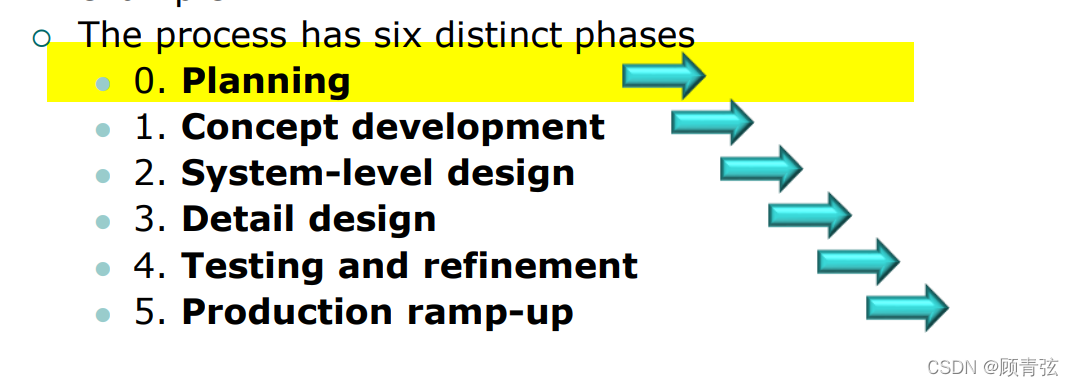北邮国院大二电商在读,随课程进行整理知识点。仅整理PPT中相对重要的知识点,个人认为相对不重要的细小的知识点不列在其中。如有错误请指出。转载请注明出处
Topic 3 - Product Planning
书接上文Topic1中的六个distinct phases

Phase 0 - Product Planning
This phase takes place before a product development project is formally approved,substantial resources are applied and the larger development team is formed
这个阶段发生在产品开发项目正式批准、应用大量资源和形成更大的开发团队之前
Product planning is an activity that considers the portfolio of projects that an organisation might pursue. i.e. what mix of new products and markets to develop, if they focus is on basic or applied research or diversification projects and determines what subset of these projects will be pursued over what time period
产品规划是一种考虑组织可能进行的项目组合的活动。例如,如果他们专注于基础研究或应用研究或多样化项目,并确定这些项目的哪个子集将在什么时期内进行,那么要开发什么样的新产品和市场组合
Phase 0 - Product Planning Problems
Organisations which do not plan carefully have the following problems
没有仔细计划的组织有以下问题
1. Inadequate coverage of target markets with competitive products
竞争产品的目标市场覆盖不足
2. Poor timing of market introductions of products
产品上市时机不佳
3. Mismatches between aggregate development capacity and the number of projects pursued
总发展能力与所进行的项目数量不匹配
4. Poor distribution of resources, with some projects overstaffed and others understaffed
资源分配不合理,一些项目人员过多,另一些项目人员不足
5. Initiation and subsequent cancellation of illconceived projects
构想拙劣的项目的启动和随后的取消
6. Frequent changes in the directions of projects
项目方向的频繁变化
Phase 0 - Product Planning – Types of projects
There are four types of Product Development Projects 产品开发项目有四种类型
1. Fundamentally new products 全新的产品
New product or production technology for new and unfamiliar markets
新产品或生产技术为新的和不熟悉的市场
2. New Product Platforms 新产品平台
New products for familiar markets and product categories
为熟悉的市场和产品类别提供新产品
3. Derivatives of existing product platforms 现有产品平台衍生品
Projects extend an existing product platform to better addresses familiar markets with one or two more products
项目将现有的产品平台扩展到一个或两个以上的产品,以更好地应对熟悉的市场
4. Incremental improvements to existing products 对现有产品的增量改进
May only involve adding or modifying some features of existing products to keep the product line current and competitive
可能只涉及增加或修改现有产品的一些功能,以保持产品线的当前和竞争力
Phase 0 - The 5-step product planning process
These 5 stages, enable the organisation to identify the Product Plan and Mission Statements
这5个阶段使组织能够确定产品计划和任务语句
1. Identify Opportunities 确认机会
2. Evaluate And Prioritise Projects 评估并确定项目的优先级
3. Allocate Resources and Plan Timing 分配资源和计划时间
4. Complete Pre-Project Planning 完成项目前期工作计划
5. Product Development Process 产品开发过程
Step 1 – Identify Opportunities
The first stage of the planning process is to identify product development opportunities
计划过程的第一阶段是确定产品开发机会
Each of the ideas should be expanded into a short description – including the potential business opportunity
每个想法都应该扩展成一个简短的描述——包括潜在的商业机会
Each of the ideas should have a ‘champion’ who is responsible for supporting the idea through the process
每个想法都应该有一个“冠军”(领导者),负责在整个过程中支持这个想法
Step 2 – Evaluate and Prioritse Projects
In this step, the organisation is looking to decide which of the projects to pursue
在这一步骤中,组织将考虑决定继续哪个项目
There are four perspectives that can be used to assist in the evaluation and analysis of each of the projects
有四个角度可以用来协助评价和分析每个项目
1. Competitive strategy 竞争战略
Four potential competitive strategies that an organisation could follow
一个组织可以遵循的四种潜在竞争战略
(1)Technology Leadership 技术领先
A focus on basic research and development of new technologies
注重基础研究和新技术开发
(2) Cost Leadership 成本领先
Competitive focus on production efficiency
注重生产效率的竞争
(3) Customer Focus 客户导向
The organisation works closely with customers to assess changing needs and preferences
该组织与客户密切合作,以评估不断变化的需求和偏好
(4)Imitative (market follower) 模仿(市场追随者)
When a clear opportunity has been identified and has been successful, the organisation launches a competitive version
当一个明确的机会被发现并获得成功时,组织就会启动一个有竞争力的版本
2. Market segmentation 市场划分
Divide the market into segments in order to be more focused on the customer and competitors
将市场细分,以便更关注客户和竞争对手
3. Technological trajectories 技术轨道
i.e. when to adopt a new technology 即何时采用新技术
When to shift to implementation of the new technology as part of the core product range
何时将新技术的实施作为核心产品范围的一部分
4. Product platforms 产品平台
The product platform is the set of assets shared across a set of products
产品平台是跨一组产品共享的资产集
An effective platform can allow a variety of derivative products to be created more rapidly and easily
一个有效的平台可以让各种衍生产品更快速、更容易地创造出来
Each product can then provide features and functions desired by a particular market segment
然后,每个产品可以提供特定市场细分所需的特性和功能
When considering opportunities in either new markets or fundamentally new technologies, the following evaluation criteria can be used
在考虑新市场或根本新技术中的机会时,可以使用下列评价标准
1. Market size (units/year x average price)
市场规模(单位/年 乘 平均价格)
2. Market growth rate (percent per year)
市场增长率(年增长率)
3. Competitive intensity (number of competitors and their strengths)
竞争强度(竞争者数量及其优势)
4. Depth of the firm’s existing knowledge of the market evaluation criteria
深入了解公司现有的市场评估标准
5. Depth of the firm’s existing knowledge of the technology
公司现有技术知识的深度
6. Fit with the firm’s capabilities
符合公司的能力
7. Fit with the firm’s other products
适合公司的其他产品
8. Potential for patents, trade secrets or other barriers to competition
潜在的专利、商业秘密或其他竞争障碍
9. Existence of a product champion within the firm
公司内部存在一个产品冠军
Step 3 – Allocate Resources and Plan Timing
There are two aspects of this step in the Process
1. Resource Allocation 资源分配
Over commitment of resources will inevitably lead to a drop in productivity
过度投入资源将不可避免地导致生产力下降
Aggregate Planning 总体计划
Pursuing only those projects that can reasonably be completed with the budgeted resources.This leads to a more efficient utilisation of the limited resources
只追求那些预算资源可以合理完成的项目。这将使有限的资源得到更有效的利用
The primary resource for a project is the human resources, i.e. the engineers and developers
项目的主要资源是人力资源,即工程师和开发人员
This concept is used to assess how long each piece of the development will take
这个概念用于评估开发的每个部分将花费多长时间
Other critical resources include 其他关键资源包括
(1)development equipment 开发设备
(2)test equipment 测试设备
(3)manufacturing capacity 制造能力
(4)availability of raw materials and components etc 原材料和零部件的可用性等
2. Project Timing 项目进度
This is the set of projects approved by the planning process
这是一组由规划过程所决定的项目
The plan may include a mix of fundamentally new products, platform projects and derivative projects
该计划可能包括全新的产品、平台项目和衍生项目
Step 4 – Complete Pre-Project Planning
After project approval, but before the commitment of resources, a pre-project planning activity takes place
在项目批准之后,但在资源承诺之前,进行项目前规划活动
This activity involves a small, cross-functional team – the Core Team
这项活动涉及一个小型的、跨职能的团队——核心团队
During this step, the Mission statement is created,included in the Mission Statement are:
在这个步骤中,创建了任务说明,在任务说明中包括:
1. A brief description of the product 产品的简要描述
2. Key business goals 关键业务目标
3. Target market for the product 产品的目标市场
4. Assumptions and constraints that guide the development effort 指导开发工作的假设和约束
5. Stakeholders 利益相关者
Step 5 – Reflect on the Results and the Process
At this step, reflection is carried out to assess both the quality of the process and the results
在这一步骤中,进行反思以评估过程的质量和结果
























 2519
2519











 被折叠的 条评论
为什么被折叠?
被折叠的 条评论
为什么被折叠?








